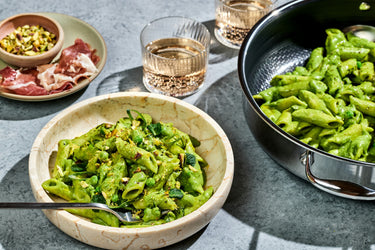How to Eat More Spring Peas

Peas may be small, but their impact is enormous. Cultivated for thousands of years, they originated in the Mediterranean before becoming a freezer staple worldwide.
Modern genetic science actually owes a debt to peas, considering Gregor Mendel famously used them in groundbreaking experiments to uncover the mechanisms of heredity. But history aside, let’s talk about what really matters: eating them.
Know your peas
When we talk about peas, we’re usually referring to shelling peas, also called garden peas or English peas (Pisum sativum). Inside their inedible pods are tender, sweet green orbs ready for gentle cooking. While flash-freezing keeps peas available year-round, fresh peas are worth seeking out at farmers’ markets in late April or early May, depending on your region. Once harvested, they last about five days in their shells when stored in the fridge.
Snow peas come from the same crop but have an entirely edible pod with smaller, less-developed peas inside. Popular in many Asian dishes, they’re often stir-fried for a crisp, fresh bite. While the whole pod is edible, removing the tough string along the back makes them even easier to eat. Sugar snap peas, a hybrid of garden and snow peas, offer the best of both worlds: a sweet, crunchy pod with plump, tender peas inside. Like snow peas, they benefit from removing the string that runs along the back.
What should you look for when buying spring peas? Head to the market, says HexClad Food Director Laura Rege. “You want to buy them as fresh as possible since they’re best right after being picked," she says.

While Laura acknowledges the advances in modern freezing capabilities, she recommends taking the time to shell peas yourself. “It’s fun and meditative,” she points out. “Plus, it’s a great activity for kids or other people in the house who want to help. You can shell peas while watching TV or listening to a podcast.”
Ultimately, investing in fresh, peak-season peas is about more than just enjoying the food, she says. “Though it takes time, shelling peas allows you to connect to the ingredient and helps you remember where the pea comes from," she says.
How to cook spring peas
Cooking peas isn’t all that different from cooking pasta, Laura says. Bring a pot of water to a boil, salt it generously, then drop them in for a minute or two until tender. Drain the peas in a sieve and run them under cold water to stop the cooking.
Blanching ensures a soft, tender inside and, crucially, prevents mushy peas. While steaming is also an option, Laura says blanching is the way to go.
Cooking with spring peas
Creamy Pasta with Peas
Peas make for a dreamy pasta sauce, their natural starchiness working with pasta water to create a silky, vibrant result. Blanching the peas and mint locks in their bright color, keeping the sauce as fresh-looking as it tastes. Blending some peas into the sauce while leaving others whole ensures both a smooth, creamy base and a bit of texture in every bite. A dollop of crème fraiche adds richness, while lemon zest and pistachios bring brightness and crunch. Keep this pea sauce method in your back pocket for a simple yet impressive way to elevate pasta.
Summer Zucchini, Feta, Mint and Pea Fritters With Poached Eggs
Peas add sweetness and a tender bite to these crispy zucchini fritters, complementing the latter's mild flavor. Pan-fried until golden, they’re perfect with poached eggs for brunch or served as a snack with a dollop of yogurt. If using fresh shelled spring peas, follow the blanching instructions above. This recipe serves two but can easily be doubled or tripled.

Peas and Goat Cheese Omelet
A great way to highlight fresh spring peas? Fold them into an omelet with soft goat cheese for a meal that’s simple yet satisfying. Whether you go for a fluffy American diner-style omelet or a silky French version, the combination of sweet peas and tangy cheese works beautifully. Finish with freshly ground black pepper, flaky sea salt, and a side of generously buttered sourdough.
Leek, Pea and Goat Cheese Frittata
Leeks, peas and goat cheese make this frittata both fresh and flavorful, while a touch of chile adds a subtle heat that lingers. Quick to make and endlessly adaptable, it’s ideal for a speedy meal—just add crusty bread to round it out. If you're using fresh spring peas, follow the blanching instructions above.
Pea and Ricotta Toast
Perhaps one of the most delicious ways to enjoy peas is on a simple ricotta toast. Toast a thick slice of country-style bread or sourdough, then slather with ricotta. Top it with a pile of blanched peas, a drizzle olive oil and a pinch of flaky sea salt and freshly ground black pepper. If you want to take it up a notch, fold in a slice or two of torn prosciutto.
Boom. Easy-peasy.






